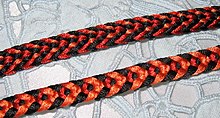Kumihimo
Kumihimo ( Japanese 組 (み) 紐 , dt. " Braided cord ") is a traditional Japanese braiding technique in which ribbons and cords are made with coiled strands of thread . By repeatedly laying the strands of yarn on top of each other in a certain order, a pattern is created. The type of pattern depends primarily on the sequence of movements, the choice of color and material and the distribution of the individual colors. The number of strands of yarn used can vary from 4 to over 170 strands, depending on the pattern and the weaving chair. In the past, silk was used as yarn, today cotton or synthetic fibers are also used. Traditionally, the technique is carried out on a wicker stool or chair. The following are used: the marudai ( 丸 台 , German “round frame ”), Kakudai ( 角 台 , German “rectangular frame ”), Ayatakedai ( 綾 竹 台 ), Takadai ( 高 台 , German “high frame”, also read Kōdai ), Naikidai ( 内 記 台 ).
A simplified type of braiding is carried out with plastic discs in which the threads are clamped. The patterns are either given with numbers, if the notches on the discs are numbered, or support templates are used. The number of strands used is limited by the number of notches (about 32).
literature
- Gabriela Markova: Japanese braiding art (Splétání technikou Kumihimo). Edited by Miriam Schwarz, CP Press (Brno) & Desicon HJ Schwarz (self-published), ISBN 3772434851
- Roswitha Schwarz; Kumihimo - (Wide bands: Japanese weaving art), Frech Verlag, 2007 ISBN 3772435912
Individual evidence
- ↑ 伊 賀 く み ひ も 組 台 の 紹 介 . In: Kumi no Sato ( 組 匠 の 里 ). 三重 県 組 紐 協同 組合 ( Eng . "Kumihimo Cooperative of Mie Prefecture "), accessed on January 2, 2010 (Japanese).
